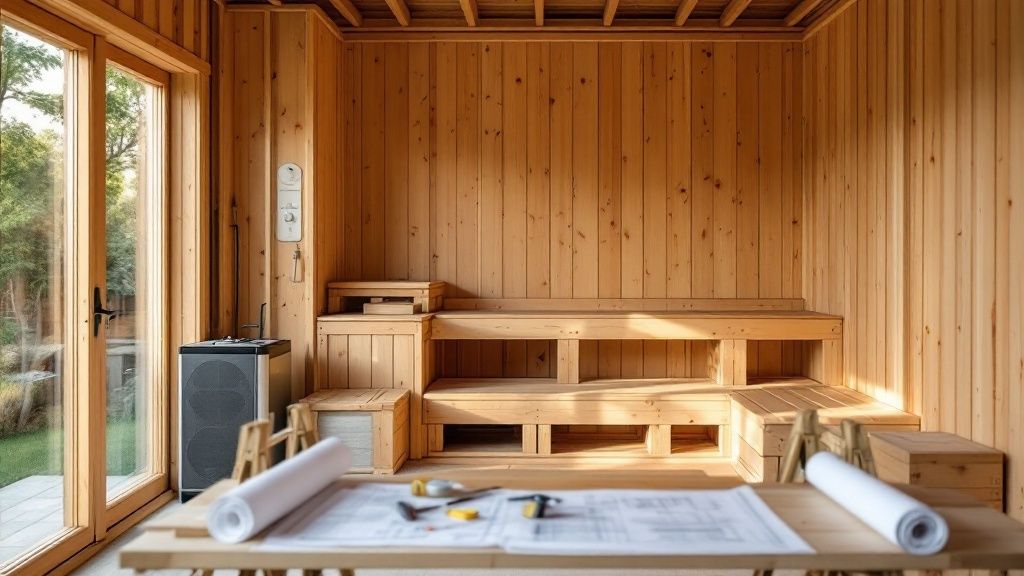
How to Build a Sauna Cheap: Affordable DIY Guide
Building a sauna often feels like an out-of-reach luxury, but I'm here to tell you it doesn't have to be. With some smart planning and a little resourcefulness, you can absolutely build a high-quality sauna without emptying your wallet. This isn't about cutting corners on what matters; it's about being clever with your materials, design, and heating choices.
Building Your Dream Sauna on a Real-World Budget
Let's get one thing straight: an affordable home sauna doesn't mean a low-quality one. The secret to building a sauna cheaply is all about being resourceful. You need to know where your money is really going so you can make strategic decisions that give you the best heat and experience for your buck. From choosing cost-effective wood to finding the right heater, every choice you make adds up.
And you wouldn't be alone. The global sauna market was valued at a staggering USD 859.5 million in 2023 and is only getting bigger. More than half of that—over 56.86%—is from people installing saunas right in their own homes. This massive trend toward home wellness shows just how many people are looking for affordable ways to bring the spa experience home. Smaller designs, locally sourced wood, and efficient infrared heaters are making it happen.
Where Does the Money Go?
To build a sauna on a budget, you first have to know where the money goes. It’s like mapping out a route before a road trip—understanding the cost breakdown helps you see exactly where you can find the biggest savings.
Here’s a look at how a typical DIY sauna budget gets divvied up.
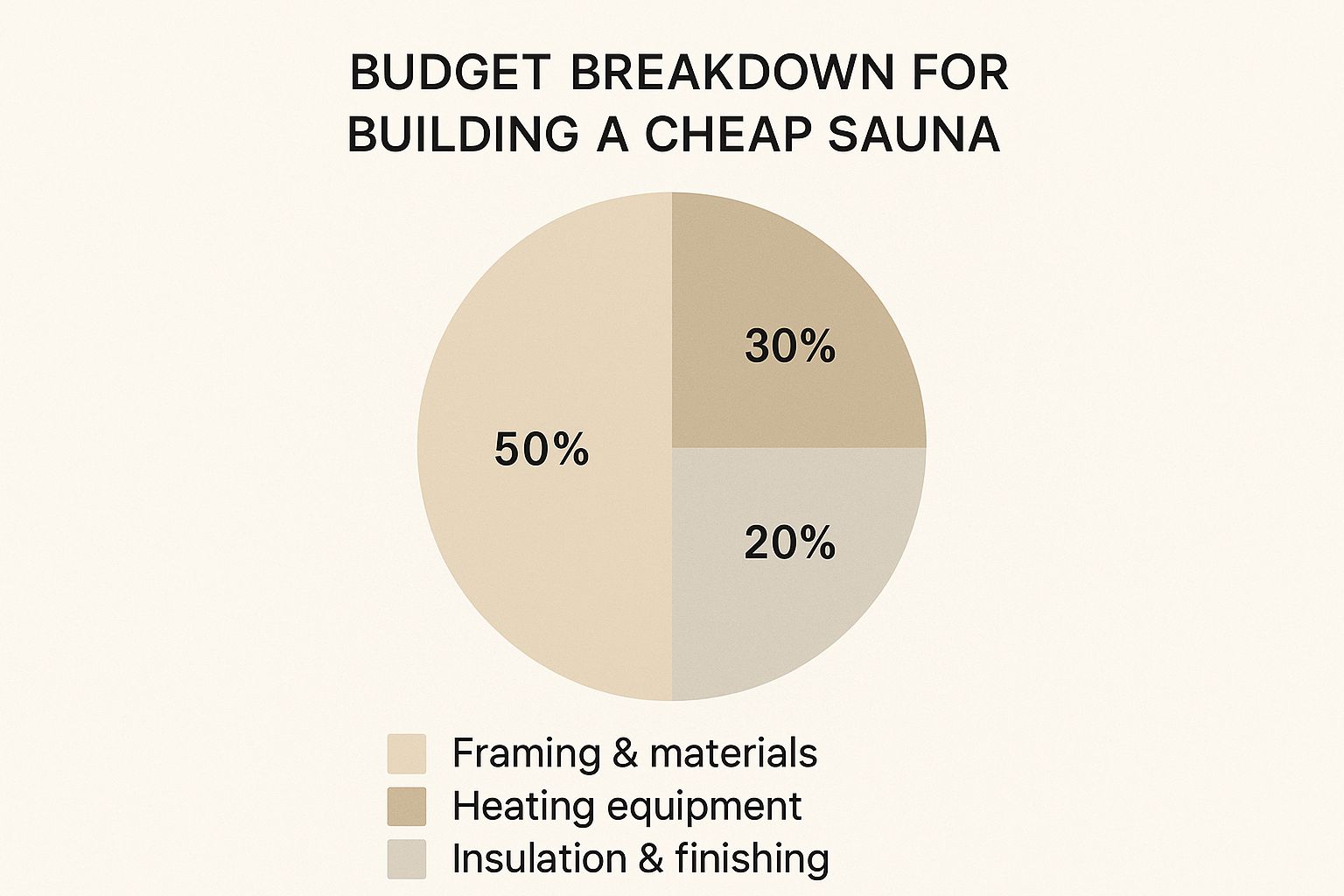
As you can see, the structure and the heater are the two heavy hitters, eating up a combined 80% of the total cost. This is fantastic news, actually. It means your biggest opportunities for savings are concentrated in just two areas.
If there's one thing to take away from this, it's that your path to an affordable sauna is paved with wise material selection and the right heating unit. Focus your budget-hacking efforts here, and you'll see the biggest impact on the final price tag.
Of course, the DIY route isn't for everyone. It saves a ton of money, but it demands your time and labor. You have to be honest with yourself and weigh that sweat equity against the convenience and guaranteed quality of a professionally built unit.
For those who want a perfect, hassle-free experience from day one, exploring your options is a smart move. When you start comparing costs, you'll want to get a full picture by reviewing our comprehensive guide on sauna installation costs.
Key Cost-Saving Decisions for Your DIY Sauna
To help you visualize where the big savings are, I've put together a table breaking down the most impactful choices you'll make. This really highlights the trade-offs between budget-friendly and premium options.
| Component | Budget-Friendly Option | Premium Option | Cost Impact |
|---|---|---|---|
| Wood | Pine, Spruce, Hemlock | Western Red Cedar, Aspen | High - Cedar can be 2-3x more expensive. |
| Heater | Standard Electric Heater | Wood-Fired Stove, High-End Electric | High - A quality wood stove can add $1,000+. |
| Size | Compact (2-3 person) | Large (4-6+ person) | High - More space means more materials and a bigger heater. |
| Insulation | Fiberglass or Rockwool Batts | Rigid Foam Panels (Polyiso) | Medium - Foam is pricier but more efficient. |
| Door | DIY Wooden Door | All-Glass Tempered Door | Medium - A pre-hung glass door can cost several hundred dollars more. |
| Flooring | Concrete Sealer, Duckboard | Tile, Specialty Sauna Flooring | Low to Medium - Depends heavily on the material choice. |
Ultimately, a budget build is a series of smart compromises. By focusing your spending on what truly matters—a solid structure and a reliable heater—you can create an amazing sauna experience that feels anything but cheap.
Your Blueprint for a Budget-Friendly Sauna
The real savings in a DIY sauna project are locked in long before you pick up a saw. Getting the design right from the get-go is your single biggest money-saver, helping you sidestep costly mistakes and cut down on wasted materials. This is where you truly figure out how to build a sauna cheap—by being clever before you even start building.
Take a good look at the space you already have. Got an awkward corner in the basement? An unused nook in the garage? These are goldmines for a sauna build. By tucking your sauna into an existing corner, you can often use two of your home's walls as part of the structure, which immediately slashes your framing budget. The idea is to design a layout that feels roomy on the inside without demanding a mountain of lumber.
For most people, a compact 2m x 2m (about 6.5ft x 6.5ft) sauna hits the sweet spot. It’s plenty of space for 2-3 people to stretch out and relax, but it’s small enough to keep your material costs and heating bills from getting out of hand. A smaller footprint doesn't just cost less to build; it’s also way more energy-efficient, saving you cash every single time you fire it up.
Nailing the Framing and Layout
When it comes to framing, don't overthink it. Standard 16-inch on-center stud spacing is all you need. Stick to the basics of solid construction and you'll be fine. The real trick here is the ceiling height. I've seen too many DIYers build their ceilings way too high, creating a huge, drafty space that their heater struggles to warm.
A lower ceiling is your friend. Aim for around 7 feet (2.1m). This simple decision keeps the precious heat concentrated down where you're actually sitting, meaning a smaller, less expensive heater can easily get the job done.
This one choice saves you money twice: first on the shorter wall studs and then again on the smaller, more affordable heater you'll be able to buy.
Getting Ventilation and Power Right from Day One
Proper airflow is an absolute must for a safe and enjoyable sauna. Luckily, it doesn't have to be complicated. A simple, passive system works wonders: just plan for a low intake vent near your heater and a high exhaust vent on the opposite wall. This creates a natural airflow that keeps things fresh. The key is to cut the openings for these while you're framing—it's a massive headache to try and add them later.
You'll want to think about your electrical plan early on, too. Most traditional sauna heaters need their own dedicated 220V circuit. It's a great idea to have a quick chat with an electrician during your planning phase. They can give you a realistic idea of the cost and help you pick a spot for your sauna that's close to your home's main electrical panel, which can save you a bundle on wiring.
Building your own sauna is an incredibly rewarding project, but it demands careful planning and a serious time commitment. If you're more focused on soaking up the wellness benefits without the construction marathon, a high-quality pre-built sauna offers fantastic value. We always encourage our readers to see the exceptional American craftsmanship in the TheraSauna Infrared Sauna line, made from beautiful, premium Aspen wood. For an incredible outdoor escape, the Mande Spa Outdoor saunas are also built in the USA from premium Aspen and designed to last. Don't let a big project stand in the way of your well-being; purchase a premium, American-made sauna today.
Sourcing Budget-Friendly Materials That Last
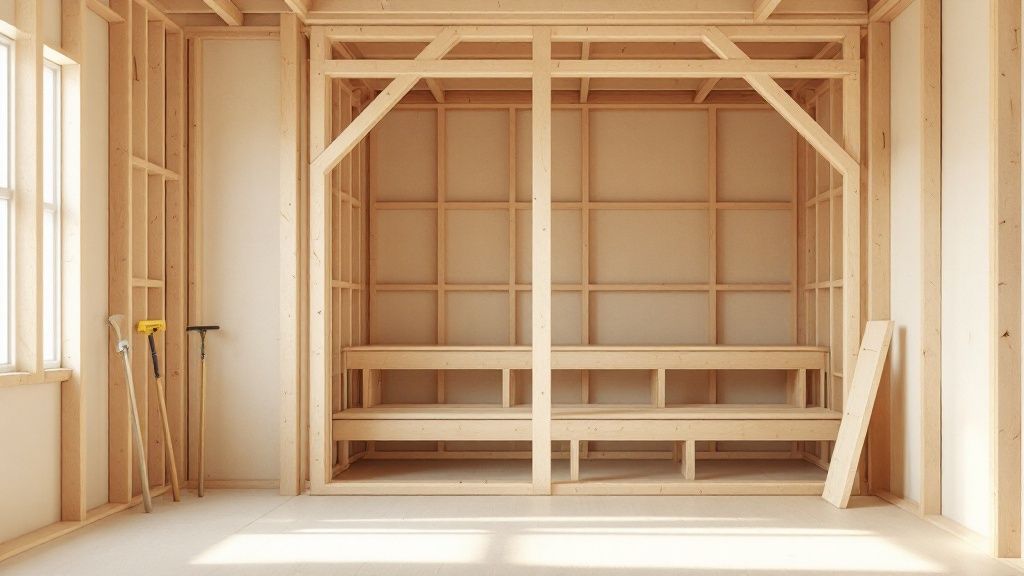
The soul of your sauna is its wood. This single material choice dictates the atmosphere, the aroma, and, let's be honest, a huge chunk of your budget. When you're building a sauna on the cheap, you don't have to sacrifice quality, but you absolutely have to be smart about what you're buying.
It's easy for first-time builders to get fixated on premium woods like Western Red Cedar. And for good reason—it’s gorgeous and naturally rot-resistant. The problem? That price tag can derail a budget build before it even starts. A much more practical approach is to look at softwoods like pine or spruce.
Now, while these woods are definitely easier on the wallet, you have to be incredibly selective. You’re looking for kiln-dried, untreated boards with as few knots as possible. Why? Because those knots contain resin that will weep and ooze at high temperatures, creating hot, sticky surprises on your walls and benches.
Finding the Best Deals on Wood
Forget the big-box home improvement stores for your main lumber purchase. Your best bet for both quality and price is almost always a local lumberyard. They tend to have better-grade materials and, more importantly, staff who actually know what they’re talking about and can help you pick the right boards for a high-heat environment.
Reclaimed wood is another avenue you can explore, but tread carefully. You must never use pressure-treated wood, painted wood, or any timber that's been chemically sealed. These materials can release toxic fumes when heated, which is the last thing you want in your personal wellness space.
Here’s a savvy move I’ve seen work wonders: mix and match your materials. Use a more affordable wood like spruce for the walls and ceiling, then splurge just a little on a higher-grade, knot-free wood for the benches—the one place your skin will make direct contact.
But what if sourcing, inspecting, and building with wood just sounds like a headache you’d rather avoid? If you want the peace of mind that comes with premium, non-toxic materials without any of the guesswork, it's worth seeing the professionally crafted alternatives. The TheraSauna Infrared Sauna and Mande Spa Outdoor saunas are the gold standard here. They're proudly made in the USA with premium Aspen wood, which is naturally hypoallergenic and stays cooler to the touch. You can learn more about the benefits of non-toxic Aspen wood in our guide. We highly encourage you to explore these options and purchase a sauna that guarantees quality.
The Non-Negotiables: Insulation and a Vapor Barrier
While you can be flexible on your wood choice, insulation and a vapor barrier are absolutely non-negotiable. Skimping here is a classic rookie mistake that will cost you far more in the long run. An uninsulated or poorly insulated sauna is an energy hog. Your heater will run constantly just to keep up, sending your electricity bill through the roof.
Think of it this way: your heater makes the heat, but your insulation keeps it. A proper wall assembly—framing, insulation, vapor barrier, and interior cladding—is what transforms a simple wooden box into an efficient, heat-retaining sanctuary.
Standard fiberglass or rockwool batts work perfectly well and are very budget-friendly. Tucked right behind your interior wood paneling, you must install a foil vapor barrier. This shiny layer does two critical jobs: it reflects radiant heat back into the sauna and, crucially, it stops moisture from seeping into your wall structure where it can cause mold and rot.
For budget-conscious projects, some of the most common cost-saving strategies include using readily available local timber, keeping the sauna's footprint small, and opting for a simple electric or wood-burning stove. Ultimately, energy efficiency itself is a cost-saving measure. Saunas built with proper insulation can dramatically reduce operational expenses over time, making a slightly higher initial investment much cheaper in the long run. Harvia offers more insights on sauna operating costs on their website.
If you’re ready to bypass the build altogether and step directly into wellness, you can purchase a premium American-made sauna today.
Choosing the Right Inexpensive Sauna Heater
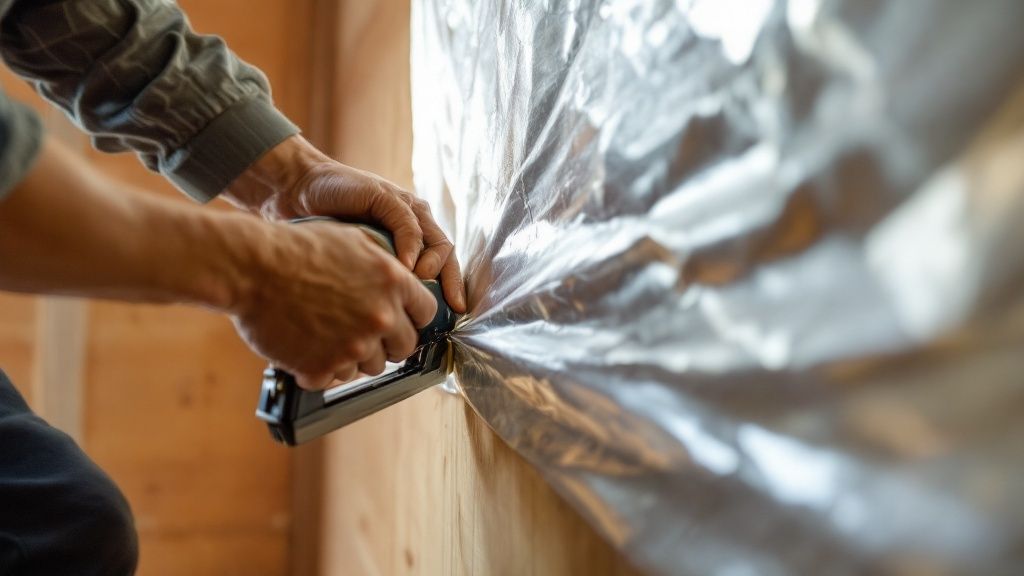
The heater is the beating heart of your sauna. It's the component that creates that deep, enveloping heat you're chasing. It’s easy to assume this is where the budget has to blow up, but that’s not the case. You can absolutely get a fantastic, sweat-inducing heat without a top-of-the-line model. The trick to building a sauna on the cheap is picking a heater that truly fits your space, your wallet, and the vibe you're going for.
When you boil it down, your choice hinges on three things: the upfront cost to buy it, how tricky it is to install, and what it'll cost you to run over time. Let's dig into the most common affordable options so you can find the perfect match for your project.
Electric Heaters: The Reliable Standard
For most indoor DIY sauna builds, a standard electric heater is the undefeated champion of cost and convenience. They’re relatively inexpensive to buy, incredibly reliable, and give you simple, precise control over the temperature.
Installation is pretty straightforward, but you'll need a qualified electrician to run a dedicated 220V circuit. This is one area you don't want to cut corners on.
- Upfront Cost: Generally low to moderate, making them a great starting point for a budget build.
- Installation: Requires a licensed electrician, which is a necessary but manageable expense.
- Operating Cost: Moderate. Your actual cost will depend on your local electricity rates and—crucially—how well you insulated your sauna.
Once you're ready to pick your heater, it pays to look at a range of high-quality options. You can browse our curated selection of top-performing Harvia sauna heaters to compare models and find one that fits your exact needs and budget.
Wood Stoves: The Rustic Choice
If you're building an outdoor or off-grid sauna, nothing beats the authentic, primal feel of a wood-burning stove. The initial cost can be a bit higher than a basic electric unit, but the long-term running cost is next to nothing if you have access to cheap or free firewood.
There’s simply no substitute for the traditional experience they offer—a soft, radiant heat combined with the crackle of a real fire.
Infrared Panels: The Modern Alternative
Infrared panels work differently. Instead of heating the air, they warm your body directly, which makes them incredibly energy-efficient. To build a cheap home sauna, many people go for smaller, pre-fab kits or DIY builds using affordable wood like pine, which keeps costs way down.
Discounted infrared models and cost-efficient electric heaters are both popular choices for getting that sauna experience without breaking the bank.
The Smart Alternative to a DIY Build
Taking on a full DIY sauna build is an amazing project, and there's a real sense of pride that comes with it. But let's be honest—it's not the only way to get an affordable, high-quality sauna in your home.
Building a sauna on a budget is about more than just the price of lumber. Your most valuable resource is your time, and a from-scratch build demands a lot of it.
Once you factor in weeks of your personal labor, the very real risk of costly first-timer mistakes, and the potential need for specialized tools you might only use once, a premium pre-built sauna starts looking like a fantastic long-term value. This is where you shift from thinking "cheap" to thinking "smart."
Why Investing in American-Made Quality Makes Sense
Instead of spending your weekends navigating complex construction plans, you could be stepping directly into a perfect sauna experience. If that sounds good to you, we strongly encourage you to see the difference for yourself by exploring the TheraSauna Infrared Sauna and Mande Spa Outdoor collections. These aren't just basic kits; they are complete wellness solutions designed by experts.
Proudly made in the USA from premium, non-toxic Aspen wood, these saunas deliver guaranteed performance and durability without any of the DIY guesswork. Aspen is a fantastic choice for saunas because it’s hypoallergenic, stays cooler to the touch, and has a clean, bright finish. Achieving that level of fit and finish on your first DIY project can be a real challenge.
Choosing a pre-built sauna isn't giving up on the dream; it's about fast-tracking your wellness journey. It’s a decision to start enjoying the incredible benefits of heat therapy now, backed by the full assurance of professional craftsmanship.
If your main goal is to have a flawless sauna experience sooner rather than later, this is absolutely your best move. You get to skip the entire construction headache and jump straight into relaxation and recovery, knowing your investment is solid and built to last for years.
Don't let a huge project stand between you and your wellness goals. Skip the build and start your journey today—purchase your American-made sauna and feel the difference that expert craftsmanship makes.
Answering Your Top Questions About Building a Sauna on a Budget
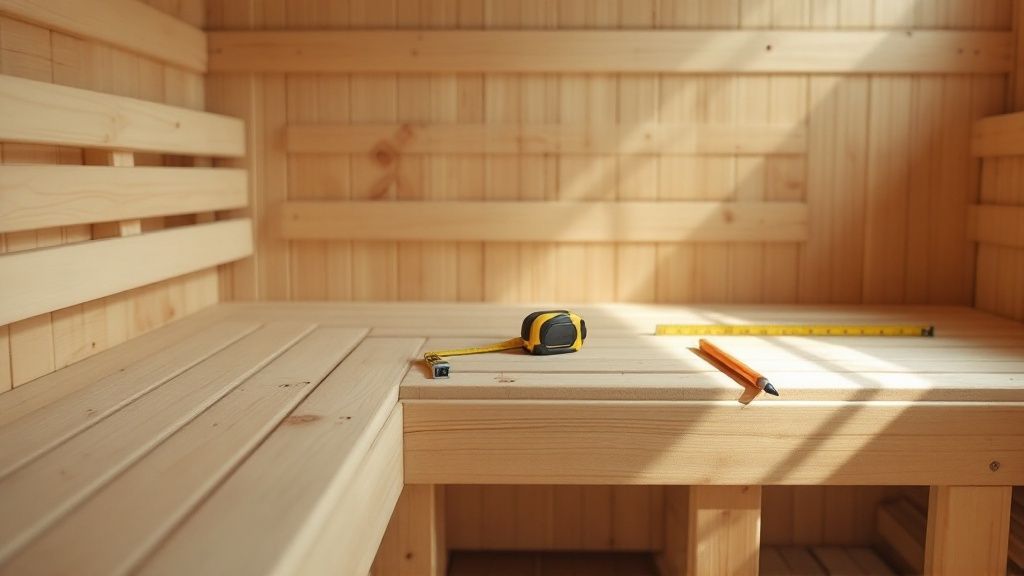
Embarking on a DIY sauna project is exciting, but it's natural to have a few questions before you start cutting lumber. Let's clear up some of the most common uncertainties I hear from builders so you can move forward with confidence and sidestep those rookie mistakes.
What Is the Absolute Cheapest Way to Build a Sauna?
Hands down, the most rock-bottom budget approach is a small, indoor 1-2 person sauna. Think about converting a closet or framing out a small corner in your basement.
To keep your costs razor-thin, you'll want to use locally sourced softwood like pine (just be picky and avoid knotty boards), find a basic electric heater, and, of course, do all the labor yourself. Hunting for reclaimed materials can also slash your budget, but you have to be absolutely certain they are untreated and safe for a high-heat environment.
Can I Use Infrared Panels Instead of a Traditional Heater?
Absolutely. In fact, infrared panels can be a brilliant choice for a budget build. Not only is their upfront cost often lower than a traditional rock heater, but they also tend to sip electricity, which saves you money every time you use your sauna.
Installation is also much simpler. They don't need the same robust ventilation or heavy-duty insulation that a traditional setup demands, cutting down on both the complexity and the material costs of your build.
Your biggest "hidden" cost is often the electrical work. Most traditional electric heaters require a dedicated 220V circuit installed by an licensed electrician. Always factor this professional expense into your budget from day one.
Are There Hidden Costs I Should Be Aware Of?
You bet. Beyond the electrician, you might run into costs for building permits (especially for outdoor structures), sudden spikes in lumber prices, or the need to rent a specific tool you don't own.
Here's my pro tip: add a 15-20% contingency to your total budget. This safety net is there to cover those little surprises that always come up during a construction project, making sure you don't get stalled halfway through.
Is It Better to Buy a Kit or Build from Scratch?
This really comes down to a trade-off between your money, your skills, and your time. Building completely from scratch is almost always cheaper if you're just looking at the material receipt.
But a kit is a huge time-saver. It eliminates the guesswork, reduces wasted materials, and helps you avoid costly beginner mistakes that can set you back.
If you want guaranteed quality without lifting a single tool, professionally crafted, American-made options deliver unbeatable value and total peace of mind.
While a DIY build is an incredibly rewarding journey, sometimes the best move is to invest in a solution that gets you to your wellness goals faster and without any of the stress. We always encourage our readers to see the exceptional quality for themselves. Take a look at the TheraSauna Infrared Sauna and Mande Spa Outdoor sauna collections. They're proudly made in the USA with premium Aspen wood and offer a perfect, hassle-free experience right out of the box. Don't hesitate to purchase a sauna that will last a lifetime.
Ready to invest in your well-being? Vitality Sauna Store offers the finest American-made saunas, built for lasting performance. Purchase your premium sauna today and feel the difference expert craftsmanship makes.